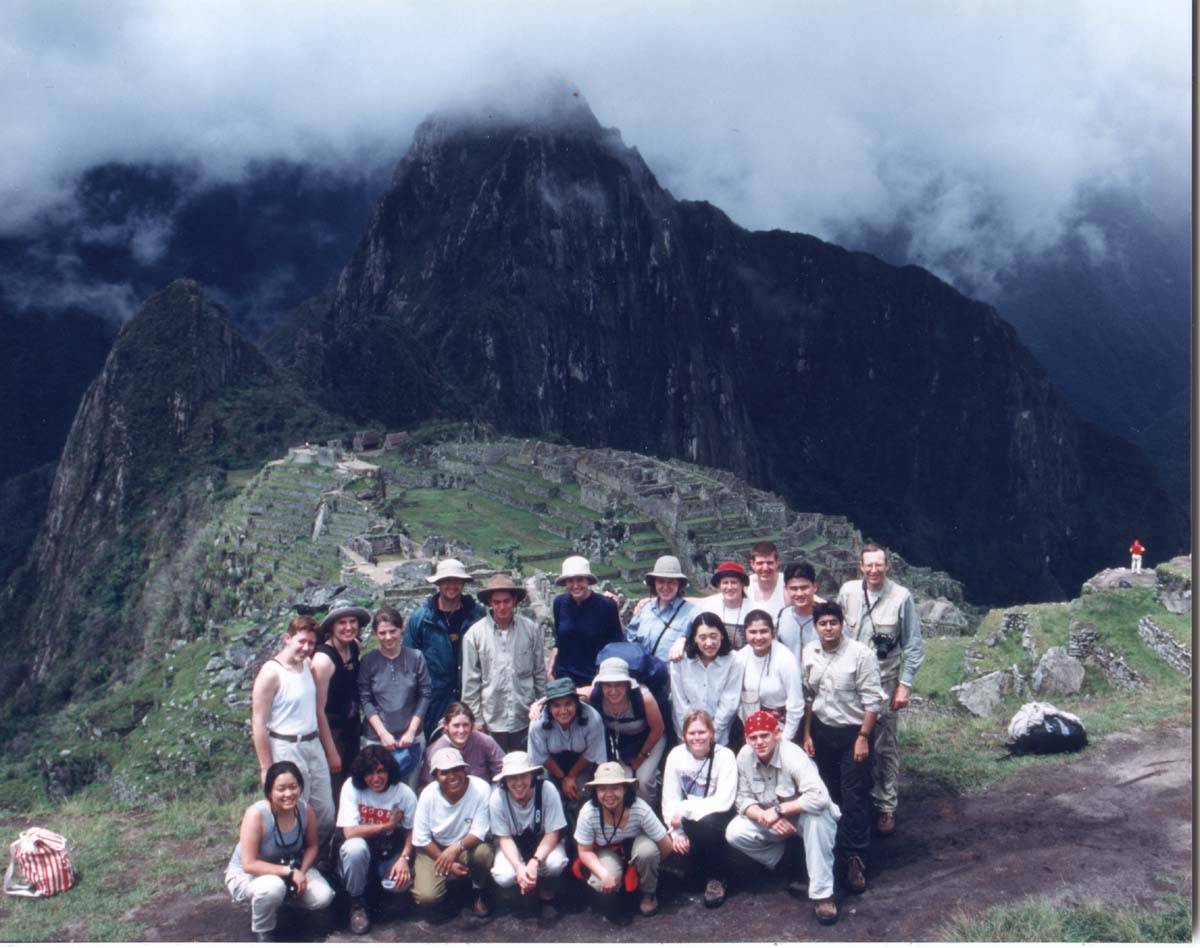Rain Forests and Patagonia
JanTerm 2001 in South America
| JanTerm 1999 Group at Machu
Picchu in the Andes of Peru Click to
see more photos

|
JanTerm 2001
This field experience in Argentina,
Bolivia, Chile, and Peru will provide an introduction to
the biology, archaeology, culture, and geology of South
America. Activities will include observation and
exploration in undisturbed Tropical Rain Forest,
Temperate Rain Forest, and Patagonian Steppe, visits to
archaeological sites including the famous Incan ruins of
Machu Picchu, the Sacred Valley of the Incas, and the
city of Cuzco, trekking and train travel in the Andes
Mountains, and camping and exploring the breathtaking
Patagonia region of southern Argentina and Chile. Animal
life, such as condors and guanacos, the huge granite
Towers of Paine, and glaciers and icebergs will be
observed. Participants should be willing to experience
the rigors of field work and camping in the tropics and
Patagonian wilderness.
|
Suggestions for What to Carry
Main Course
Information Memo- Please read
this information carefully
Rain Forests and Patagonia
3 Leave DFW in the afternoon.
4 Arrive Lima, PERU early morning; day free to explore
Lima.
5 Fly to Cuzco, Peru; free afternoon in Cuzco; adjust to
elevation; welcome dinner. Cuzco is the ancient capital of the
Incan Empire and is a fascinating city with Incan ruins, Spanish
colonial architecture, and mountain scenery.
6 Morning city tour of Cuzco and nearby ruins; afternoon free
to explore Cuzco (market, museums, etc.).
7 Tour of Sacred Valley of Incas (Pisac and Ollantaytambo) in
the morning; whitewater rafting in the afternoon on the
incredible Urabamba River.
8 Train to Machu Picchu area; mini-trek to ruins; overnight
Aguas Calientes just below Machu Picchu.
9 Full day at Incan Ruins of Machu Picchu; return by train to
Cuzco.
10 Flight to Puerto Maldonado in the Amazon; large dugout
canoe to Heath Rainforest Lodge (BOLIVIA). The lodge we
will be staying in is in Bolivia just across the Peruvian border.
It is very near new Madidi National Park featured on the cover of
a recent issue of National Geographic.
11 Heath Rainforest Lodge; rainforest hikes; viewing of macaw
clay licks, monkeys.
12 Heath Rainforest Lodge; observations in new Madidi National
Park; hikes to observe birds, tapiers, etc.
13 Heath Rainforest Lodge; rainforest hikes; interacting with
researchers. The Heath Lodge is in a very remote region where the
animal diversity is nearly intact. We will see a wide diversity
of wildlife.
14 Travel to Lake Sandoval Rainforest Lodge; observation of
the rare giant otter.
15 Go by large canoe from lodge to Puerto Maldonado; fly to
Lima.
16 Fly from Lima, Peru to Santiago, CHILE and then to
Punta Arenas, Chile; overnight in hotel. Punta Arenas is located
in the extreme southern part of Chile in the region known as
Patagonia, sometimes referred to as “the uttermost end”
because it is literally at the end of the South American
landmass.
17 Drive to Seno Otway (Otway Sound) on the Straits of
Magellan and visit the penguin rookery; continue on to Torres del
Paine National Park; make camp. Torres del Paine is an incredible
place with towering peaks of mixed volcanic and sedimentary rocks
partially surrounded by glaciers; we'll sleep to the sounds of
falling ice and rock. This is one of the most spectacular places
on the South American continent.
18 Full day hike up Valle Ascensio to base of the Towers of
Paine; return to camp.
19 Break camp; drive to Salto Grande; cross lake by catamaran
and set up camp at Pehoe.
20 Day hike to Grey Glacier; return to camp.
21 Day hike to Valle Francais; return to camp.
22 Break camp; recross lake by catamaran; drive across
international border to ARGENTINA to El Chalen near
Fitzroy; establish camp. Fitzroy is an incredible 11,073 foot
jagged granite pinnacle that thrusts upwards 6,000 feet above the
glaciers at its base.
23 Hike Lago de los Tres; view wildlife (guanacos, Andean
condors, etc.) camping.
24 Hike Lago Torre; camping.
25 Hike Peligue Tumbado; camping.
26 Break camp and drive to Lago Argentino; camp at Brazo Rico
(campground has hot showers, etc.)
27 Visit Moreno Clacier (a World Heritage site) and do glacier
trek; camping. Moreno Glacier has a main wall over 200 feet
tall and almost 3 miles wide. Occasionally huge chunks break off
or “calve,” falling into the lake below and creating
giant icebergs. This is in Los Glaciares National Park in the
sub-Antarctic Continental ice-cap known as the "third
pole."
28 Hike Cerro Crystal (or relaxation day: options include
birding, fishing, etc); camping
29 Drive to Puerto Natales; overnight in hotel; farewell
dinner.
30 Depart Punta Arenas, Chile for Santiago, Chile and begin
flight to DFW.
31 Morning arrival at DFW airport.
To
Contact Dr. Diggs:
Austin College Phone: (903) 813-2246, Home
Phone (903) 868-1642
Office: 317 Moody Science
Mailing Address: Department of Biology, Austin College, Sherman,
TX 75090
AC Suite 61564
e-mail: gdiggs@austinc.edu
Home page: http://artemis.austincollege.edu/acad/bio/gdiggs/diggs.html
Office Hours: 1:30-2:30 M, Tu; Other times by appointment.

